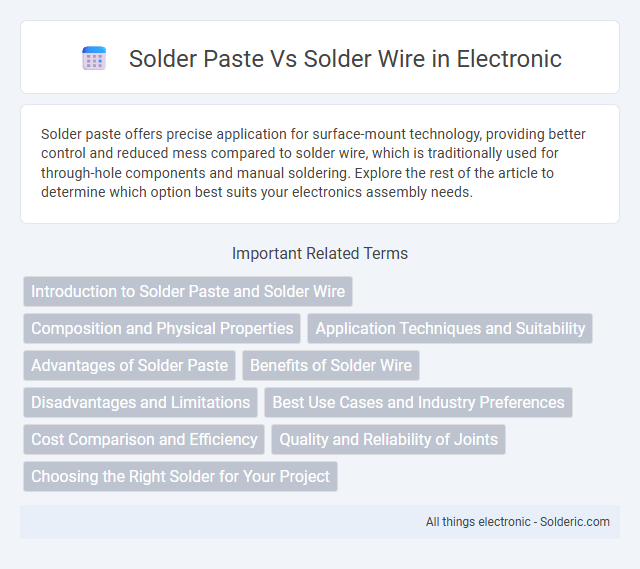Solder paste offers precise application for surface-mount technology, providing better control and reduced mess compared to solder wire, which is traditionally used for through-hole components and manual soldering. Explore the rest of the article to determine which option best suits your electronics assembly needs.
Comparison Table
| Feature | Solder Paste | Solder Wire |
|---|---|---|
| Form | Thick, viscous paste containing solder powder and flux | Solid wire, typically 0.2mm to 1.6mm diameter |
| Use Case | Surface mount technology (SMT) and reflow soldering | Through-hole soldering and manual hand-soldering |
| Application Method | Stencil printing or dispensing | Direct feeding or manual placement |
| Flux Content | Included within the paste | Core flux inside wire or separate flux applied |
| Storage | Requires refrigeration to prevent drying and oxidation | Stable at room temperature |
| Longevity | Limited shelf life, typically weeks to months | Long shelf life, typically years |
| Precision | High precision placement for complex PCB layouts | Less precise, suitable for larger components and repairs |
| Common Alloys | Sn63Pb37, SAC305 (Sn96.5Ag3.0Cu0.5) | Sn60Pb40, Sn63Pb37, lead-free variants |
Introduction to Solder Paste and Solder Wire
Solder paste is a mixture of powdered solder and flux, designed for surface-mount technology (SMT) applications where precise deposition on circuit boards is required. Solder wire, typically composed of a metal alloy such as tin-lead or lead-free alternatives, is used in through-hole soldering and manual soldering processes. Both materials serve the fundamental purpose of creating reliable electrical and mechanical connections in electronic assemblies.
Composition and Physical Properties
Solder paste consists of microscopic metal alloy particles suspended in flux, offering precise application for surface mount technology, while solder wire is a solid metal alloy usually composed of tin, lead, or lead-free alternatives like tin-silver-copper, designed for manual or automated soldering. The viscous nature of solder paste allows for controlled deposition on printed circuit boards, whereas solder wire melts and flows easily, making it suitable for point-to-point solder joints. Understanding the differences in composition and physical state helps you choose the right solder material for your electronics assembly needs.
Application Techniques and Suitability
Solder paste is ideal for surface-mount technology (SMT) applications where precise application using stencils or dispensers is required, ensuring consistent solder deposits on PCB pads. Solder wire suits through-hole soldering or manual touch-up because it melts directly upon heating and is easier for dynamic, selective application. Your choice depends on the component type and assembly process, with paste favored for automated mass production and wire for quick repairs or low-volume tasks.
Advantages of Solder Paste
Solder paste offers precise application and excellent control for surface mount technology (SMT) components, improving solder joint quality and consistency. Its formulation includes flux and metal powder, which enhances wetting and reduces oxidation during reflow soldering. You benefit from faster assembly processes and better reliability in high-volume or complex circuit board manufacturing.
Benefits of Solder Wire
Solder wire offers precise control and ease of application, making it ideal for manual soldering tasks in electronics assembly. Its straightforward form allows for quick heating and melting, resulting in strong, reliable joints with excellent electrical conductivity. Solder wire also reduces the risk of mess and waste, promoting cleaner workspaces and efficient use of materials.
Disadvantages and Limitations
Solder paste can suffer from a limited shelf life and requires precise storage conditions to maintain its flux activity, leading to potential reliability issues if improperly handled. It also demands specialized application equipment and can cause bridging or voids if not accurately dispensed, making it less suitable for manual soldering. Solder wire, while easier to handle manually, has limitations in achieving consistent solder joint quality on fine-pitch components and can introduce flux residues that require thorough cleaning to prevent corrosion or electrical shorts.
Best Use Cases and Industry Preferences
Solder paste is preferred for surface-mount technology (SMT) applications in electronics manufacturing due to its precise deposition and suitability for reflow soldering, making it ideal for high-volume production and complex circuit boards. Solder wire is commonly used in through-hole soldering and manual touch-up work, favored in repair, prototyping, and small-scale assembly because of its ease of use and availability in various alloys and diameters. Industry preferences lean toward solder paste in automated processes within consumer electronics and automotive sectors, while solder wire remains a staple in electronics repair shops and hobbyist projects.
Cost Comparison and Efficiency
Solder paste typically incurs higher initial costs due to specialized storage and application equipment, while solder wire presents a lower upfront investment and is widely available. Efficiency-wise, solder paste excels in automated surface-mount technology (SMT) processes, enabling faster and more precise application on printed circuit boards (PCBs) compared to manual solder wire use. For large-scale manufacturing, solder paste reduces material waste and rework, improving overall production cost-effectiveness despite its higher price point.
Quality and Reliability of Joints
Solder paste offers superior quality and reliability in joints due to its precise metal powder and flux composition, ensuring consistent wetting and strong mechanical bonds in surface-mount technology applications. Solder wire, while easier to use for through-hole soldering, may lead to variable joint quality because of potential inconsistencies in heat application and flux distribution. Choosing the right solder material directly impacts Your electronic assembly's durability and performance, with solder paste often preferred for high-precision and high-reliability requirements.
Choosing the Right Solder for Your Project
Choosing the right solder for your project depends on the application requirements and project specifications. Solder paste is ideal for surface mount technology (SMT) and provides precise solder placement, making it essential for complex PCB assemblies. Solder wire suits through-hole soldering and quick repairs, offering ease of use and control for manual soldering tasks.
solder paste vs solder wire Infographic

 solderic.com
solderic.com